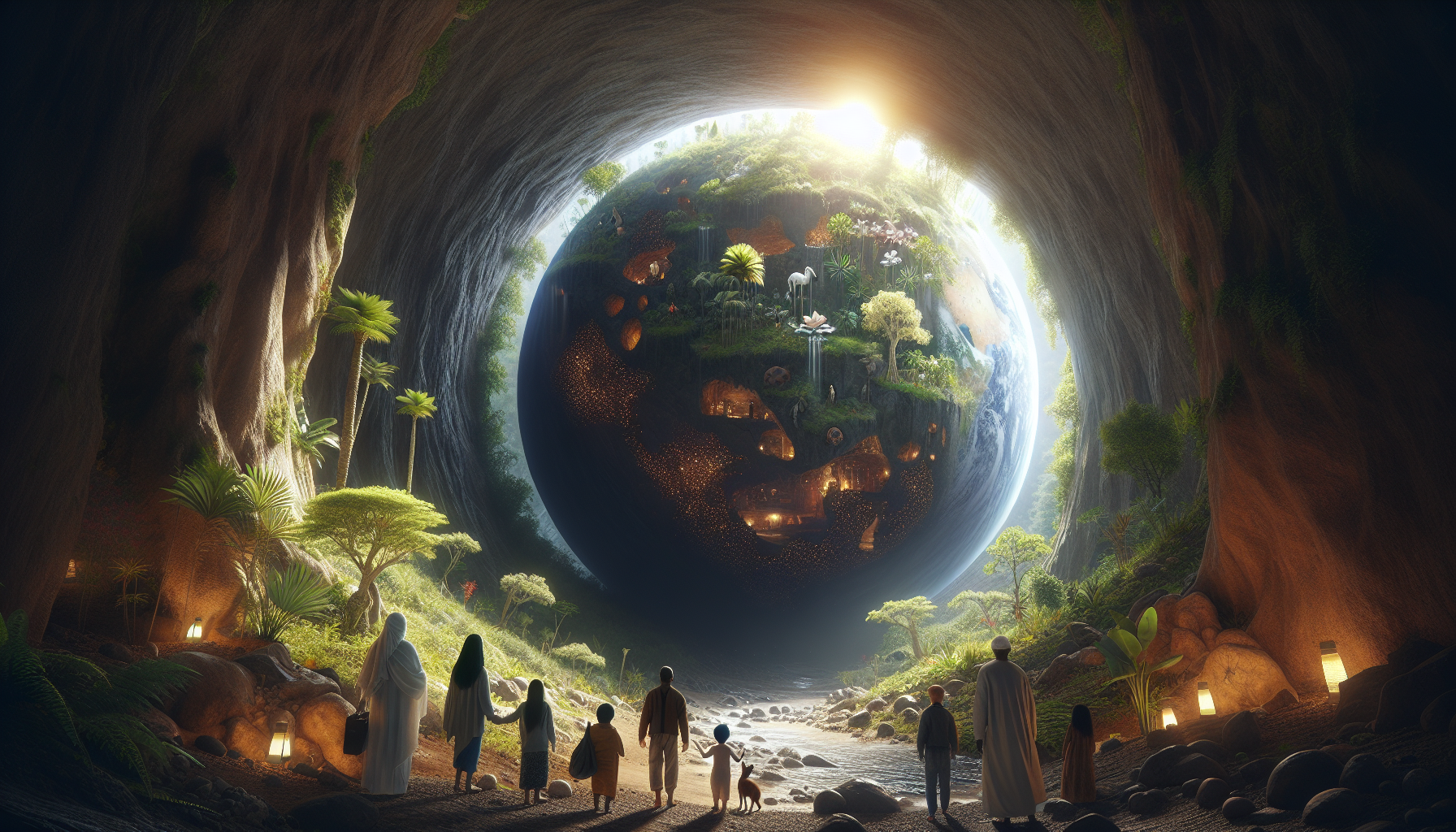In the vast tapestry of human curiosity, few threads are as captivating and enigmatic as the concept of the Hollow Earth. Imagine a world within our world, a mysterious realm that, for centuries, has ignited the imagination of explorers, scientists, and dreamers alike. This intriguing theory, nestled on the fringes of conventional science, proposes the existence of vast, unexplored landscapes beneath our feet, complete with its own ecosystems, civilizations, and secrets waiting to be uncovered. As we embark on this journey through the realms of possibility and speculation, prepare to have your perceptions challenged and your sense of wonder reignited. 🌍✨
The allure of the Hollow Earth theory is not merely a relic of ancient myth or speculative fiction; it has been a subject of genuine scientific inquiry and popular fascination throughout history. From the early musings of Edmund Halley in the 17th century, who suggested that the Earth might consist of concentric shells, to the imaginative tales of Jules Verne and Edgar Rice Burroughs, the idea of subterranean worlds has persistently captured the human imagination. But what if there is more to this theory than just stories? What if, buried beneath layers of rock and time, lies a hidden truth about our planet’s structure that could redefine our understanding of the Earth itself? In this article, we will delve into the origins of the Hollow Earth theory, explore the scientific perspectives for and against it, and examine the cultural impact it has had over the centuries.
As we journey deeper into the topic, we will uncover the fascinating narratives and personalities that have contributed to the Hollow Earth discourse. We will explore the scientific advancements that have both supported and debunked elements of the theory, and we will consider the technological and philosophical implications of discovering such a world. Could there be untapped resources or unknown life forms dwelling in subterranean expanses? How have myths and legends from different cultures fueled the speculation of inner worlds? And, perhaps most intriguingly, what does our fascination with the Hollow Earth reveal about our innate desire to explore the unknown? Join us as we peel back the layers of mystery and venture into the depths of the Earth, where science, myth, and the human spirit of exploration converge in a thrilling narrative of discovery.
The Origins of the Hollow Earth Theory
The Hollow Earth theory, a captivating concept suggesting that our planet might not be as solid as we assume, has roots tracing back to ancient civilizations and has fascinated thinkers for centuries. While most of modern science supports the solid earth model, the idea of a subterranean world persists, largely due to its historical allure and the imagination it provokes. The initial seeds of this theory can be found in the mythology and folklore of many cultures, where tales of underground realms and creatures abound. For instance, the ancient Greeks spoke of Hades, the underworld; Nordic legends tell of Svartalfheim, home to dark elves; and Hindu texts describe Patala, a subterranean region inhabited by serpentine beings.
In the 17th century, the Hollow Earth theory began to gain scientific traction when Edmund Halley, the famed astronomer who discovered Halley’s Comet, proposed that the Earth might consist of a hollow shell about 500 miles thick, with two inner concentric shells and an innermost core. Halley suggested that these layers could have their own atmospheres, supporting life. This notion was an attempt to explain anomalous compass readings and accounted for the Earth’s magnetic field in a way that the science of the time struggled to do. Halley’s proposal captured the imagination of the public and inspired a wave of speculation and storytelling that continues to this day.
As scientific understanding progressed, the 18th and 19th centuries saw further development of the Hollow Earth hypothesis, albeit with increasing skepticism from the scientific community. Notably, John Cleves Symmes Jr., an American Army officer, fervently advocated the idea in the early 1800s. He theorized that massive openings at the poles could serve as entrances to the inner Earth. His public lectures and writings attracted considerable attention and inspired other enthusiasts, despite lacking empirical evidence. The legacy of these early theorists has had a lasting impact on both science fiction literature and the broader public imagination, keeping the Hollow Earth theory alive in cultural narratives.
Scientific Perspectives and Criticisms
Despite its intriguing premise, the Hollow Earth theory has faced significant criticism and has been largely discredited by the scientific community. Modern geology, supported by robust evidence, maintains that the Earth is composed of a solid crust, a highly viscous mantle, and a dense, metallic core. This understanding is reinforced by seismic data, which reveal how waves from earthquakes travel through the planet, providing a detailed picture of its internal structure. These waves behave in ways that would be impossible if the Earth were hollow, thereby supporting the solid Earth model.
Moreover, the theory lacks empirical support in several other key areas. For instance, the gravitational force observed on Earth’s surface can only be explained if the planet has a substantial mass. A hollow Earth would not possess sufficient mass to exert the gravitational pull we experience. Additionally, the phenomenon of tectonic activity, responsible for earthquakes and the movement of continental plates, further invalidates the concept of a hollow Earth. These geological processes are well-understood within the context of a solid Earth model and align with a myriad of observational data.
Critics also point to the logistical and practical impossibilities inherent in the Hollow Earth theory. The idea of vast openings at the poles, as suggested by Symmes and others, is inconsistent with extensive polar explorations and satellite imagery. Furthermore, the absence of tangible evidence, such as photographs or physical samples, leaves the theory firmly in the realm of speculation rather than science. Despite these challenges, the notion of a Hollow Earth endures, partially because it offers an imaginative escape from reality and a platform for storytelling and exploration in literature and media.
Cultural Impact and Representations
The Hollow Earth theory has not only sparked scientific debate but also inspired countless cultural representations across various media. Literature, in particular, has embraced the concept, offering readers adventures into mysterious underground worlds. One of the most famous literary works inspired by this theory is Jules Verne’s “Journey to the Center of the Earth,” published in 1864. This novel takes readers on an expedition through volcanic tunnels to an expansive subterranean world filled with prehistoric creatures and natural wonders. Verne’s imaginative storytelling has left an indelible mark on science fiction, influencing subsequent works and adaptations in film and television.
In addition to literature, the Hollow Earth theory has found a place in modern popular culture. Movies, television series, and video games frequently explore themes of hidden worlds beneath the Earth’s surface. For instance, the film “Kong: Skull Island” (2017) and its sequel, “Godzilla vs. Kong” (2021), incorporate elements of the Hollow Earth theory, using it as a backdrop for epic monster battles and explorations. These representations play on the allure of the unknown, allowing audiences to suspend disbelief and imagine the possibilities of life below the Earth’s crust.
The enduring popularity of the Hollow Earth theory can be attributed, in part, to its versatility as a narrative device. It provides a canvas for exploring themes of discovery, adventure, and the unknown. This cultural fascination with hidden worlds continues to captivate audiences, inviting them to ponder what lies beneath their feet and fueling a sense of wonder about the mysteries of our planet.
The Future of Hollow Earth Exploration
As we continue to advance in technology and scientific understanding, the future of exploring the Hollow Earth theory remains uncertain but intriguing. While modern science largely dismisses the notion of a hollow planet, the allure of subterranean exploration persists. In recent years, technological innovations such as deep-earth drilling and advanced imaging techniques have allowed scientists to probe the Earth’s crust more thoroughly than ever before. These advancements have the potential to uncover new insights about our planet’s geology and potentially reveal unknown aspects of its structure.
Explorers and researchers are also leveraging virtual reality and computer simulations to create immersive experiences that allow people to explore hypothetical underground worlds. These tools provide a unique opportunity to visualize what life might be like in a hollow Earth scenario, combining scientific knowledge with imaginative storytelling. Such experiences not only entertain but also educate, sparking curiosity and encouraging further inquiry into the mysteries of our planet.
While the Hollow Earth theory may never be proven, its legacy as a catalyst for exploration and creativity is undeniable. As long as there is a human desire to uncover the unknown, the concept of a world within our world will continue to inspire and captivate. Whether through scientific investigation or creative exploration, the journey to understand the mysteries beneath our feet is an enduring adventure.
| Aspect | Solid Earth Model | Hollow Earth Theory |
|---|---|---|
| Seismic Data | Supports solid layers | Lacks evidence |
| Gravitational Force | Explained by substantial mass | Inconsistent with hollow model |
| Tectonic Activity | Consistent with solid Earth | Not explained by theory |
For a more visual exploration of the Hollow Earth concept, you might find this video engaging: “Journey to the Hollow Earth” by Sci-fi Uncovered. 📺
Modern Interpretations and Speculative Theories
In contemporary discourse, the Hollow Earth theory has evolved to incorporate elements of speculative science and alternative history. Some modern interpretations suggest that ancient civilizations possessed advanced knowledge of the Earth’s structure, which has been lost over time. Proponents of these ideas often point to enigmatic structures like the Great Pyramid of Giza or the stone carvings at Puma Punku as evidence of a deeper understanding of the Earth’s mysteries. They speculate that these ancient cultures might have had access to knowledge about subterranean realms or even communication with entities from within the Earth.
Another intriguing aspect of modern Hollow Earth theories involves the possibility of undiscovered ecosystems below the surface. Scientists studying extremophiles—organisms that thrive in extreme conditions—have discovered life in places once thought uninhabitable, such as deep ocean vents and the Earth’s crust. These findings suggest that life might exist in unexpected places, potentially even beneath the Earth’s surface. While the idea of a fully-fledged ecosystem within a hollow Earth remains speculative, the discovery of extremophiles challenges our understanding of the limits of life and fuels curiosity about what lies beneath.
Beyond scientific speculation, the Hollow Earth theory continues to serve as a platform for imaginative exploration in fiction and media. From novels and films to video games and virtual reality experiences, the concept provides endless possibilities for storytelling. It invites us to envision worlds beyond our current understanding, encouraging creativity and wonder. As our knowledge of the Earth and its potential hidden secrets expands, the allure of the Hollow Earth theory persists, reminding us of the power of curiosity and the enduring human quest for discovery.
- Historical roots in ancient mythology
- Scientific perspectives and criticisms
- Cultural impact and media representations
- Future possibilities for exploration
- Modern interpretations and speculative theories

Conclusion
Unveiling the mysteries of the Hollow Earth theory has undoubtedly taken us on a captivating journey through the annals of speculative science and imaginative fiction. As we delved into this intriguing concept, we explored the historical roots, scientific debates, and cultural impact that the theory of a world within our world has evoked over centuries.
We began by examining the origins of the Hollow Earth theory, tracing its lineage from ancient mythologies to its more structured form in the Enlightenment era. Early thinkers like Edmond Halley and later proponents such as John Cleves Symmes Jr. offered hypotheses that challenged conventional wisdom, proposing the existence of vast, unexplored realms beneath our feet. Despite being at odds with established scientific principles, their ideas captured the imagination of many, setting the stage for an enduring debate that continues today.
The scientific community’s response to the Hollow Earth theory has been marked by skepticism, primarily due to the lack of empirical evidence and the advancements in geology and physics that refute the existence of such subterranean worlds. Seismic studies and understanding of Earth’s layers provide a clear picture of our planet’s composition, leaving little room for the possibility of hollow regions. Nevertheless, the allure of undiscovered territories beneath the surface fuels ongoing fascination and curiosity.
Culturally, the Hollow Earth theory has left an indelible mark, inspiring literature, films, and other forms of storytelling. Classic works like Jules Verne’s “Journey to the Center of the Earth” and Edgar Rice Burroughs’ Pellucidar series invite readers to imagine what wonders and dangers might lie beneath the Earth’s crust. These narratives, while fictional, underscore humanity’s innate desire to explore the unknown and challenge the boundaries of accepted knowledge.
The enduring appeal of the Hollow Earth theory can be attributed to its ability to spark the imagination and its intersection with contemporary themes such as hidden ecosystems, unexplored frontiers, and the mysteries of our planet. In an era of rapid technological advancement and exploration, the concept of a hidden world serves as a metaphor for the uncharted territories still left to discover, both on Earth and beyond.
The exploration of the Hollow Earth theory also prompts us to reflect on the importance of maintaining an open mind while grounding our understanding in scientific evidence. The tension between skepticism and wonder is a driving force in the pursuit of knowledge, reminding us that the most significant discoveries often arise from questioning the status quo and exploring the possibilities beyond conventional thinking.
In conclusion, while the Hollow Earth theory may not hold up to scientific scrutiny, its impact on culture and the human imagination is undeniable. It invites us to consider the limits of our understanding and the potential for new discoveries that await. As we continue to explore the mysteries of our world and beyond, let us remain inspired by the spirit of inquiry that the Hollow Earth theory embodies. 🌍
We encourage you to share your thoughts and engage in discussions about this fascinating topic. Whether you’re a skeptic or a believer, the conversation about what lies beneath our feet is as compelling as ever. Feel free to comment below, share this article with others who might be intrigued, and continue to explore the uncharted territories of both the mind and the planet. Together, we can unravel the mysteries of our world, one theory at a time.
For further reading on the subject, you might find these resources enlightening:
1. National Geographic’s exploration of Earth’s geology National Geographic
2. A comprehensive look at the history of the Hollow Earth theory History.com
3. An article on the cultural impact of the Hollow Earth in literature Smithsonian Magazine
Let’s continue to foster curiosity and expand our horizons. After all, the pursuit of knowledge is a journey with no end, only new beginnings. 🌌
Toni Santos is a visual storyteller and conceptual archivist whose work explores the curious, often poetic ruins of pseudoscience and obsolete theories. With a reverence for forgotten frameworks and fantastical logic, Toni illuminates the imaginative spaces where science once drifted into myth, speculation, and symbolic belief.
His creative path is rooted in a fascination with the fringe — from phrenology maps to ether diagrams, hollow earth charts to animal magnetism illustrations. Each visual Toni creates or curates is an invitation to reexamine the strange beauty of discarded knowledge — not as failure, but as cultural reflection, as art born from our eternal desire to explain the unexplainable.
Blending visual design with historical inquiry, Toni gives new life to lost diagrams, metaphysical charts, and antique engravings that once shaped worldviews. His work occupies the liminal zone between fact and fiction, where obsolete models still pulse with philosophical resonance and forgotten charm.
As the mind behind Vizovex, Toni shares illustrated essays, curated collections, and visual reinterpretations that invite others to explore the aesthetic and symbolic value of outdated theories. His goal is not to validate, but to remember — to view these speculative systems as relics of human creativity, vulnerability, and yearning.
His work is a tribute to:
The elegance of error in the evolution of knowledge
The symbolic artistry of discarded explanations
The blurred lines between belief, observation, and imagination
Whether you’re a collector of curious ideas, a lover of forgotten diagrams, or someone drawn to the strange scaffolding of old worldviews, Toni opens a portal to a time when the universe was still full of ghosts, humors, and cosmic fluids — one chart, one symbol, one discredited wonder at a time.





